*Pumpkin Puree doesn’t have to come from a can! Homemade is infinitely better, in my opinion. Let me show you how to make your own super smooth, sweet, and flavorful pumpkin puree with ease.

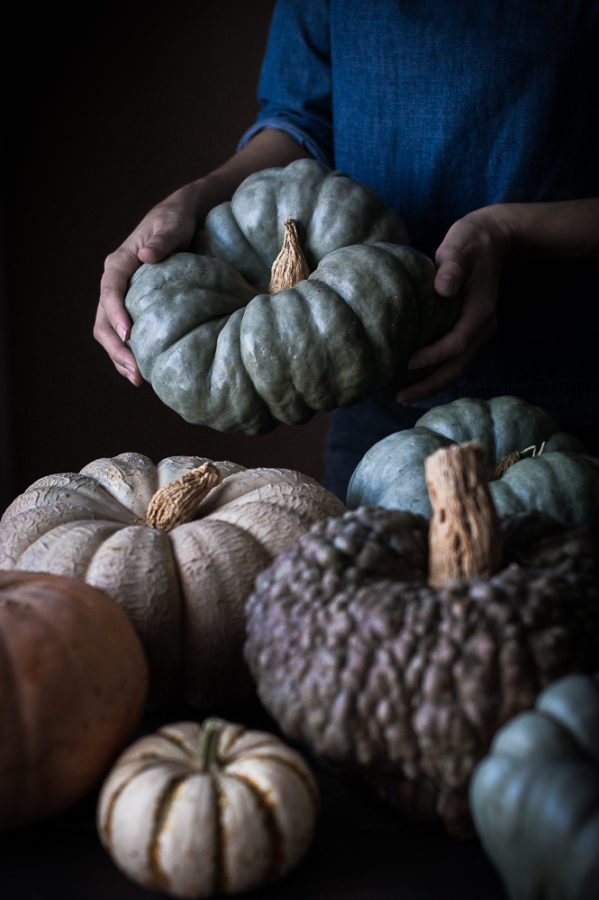
I’ve always liked pumpkins. Not in a manic, obsessive sort of way, but more your typical “hey, that’s a pretty blue sky” sort of way. Observant of their beauty and merited place in the culinary world, but certainly never going out of my way to cook with them or admire their endless varieties.
If I cooked with pumpkin, it was on occasion and that occasion was making this Curried Coconut Pumpkin Bisque. If I baked with pumpkin, or had the urge to make my own pumpkin puree, little sugar pumpkins were my go-to. And to be down-right honest, I was never all too smitten with them. For something called a sugar pumpkin I never really felt it lived up to it’s name, being just “ok”, at best.
Every preconceived notion I had regarding the “wow factor” possessed by pumpkins (and squash, really) was obliterated this fall as I walked into a local market to buy a few green pumpkins for a shoot and was met by an array of colors, textures and sizes. Grey/green pumpkins the size of a small child with steep ridges and smooth skin that glistened with an almost metallic sheen. Fat blush colored pumpkins crusted with what can only be described as a peanut shell-like coating, stunning in their bizarre appearance. Deep purple-green squash that looked like giant acorns, with fabulously bumpy skin reminiscent of the skin of a fairytale troll. So many pumpkins and squash that I had never seen before in my 32 years. Or maybe I’ve just never noticed them? Sufficed to say, I bought more pumpkins this year than in my whole adult life combined.
There is just something about the remarkable diversity and imperfect beauty of these pumpkins that make my heart beat faster and put butterflies in my stomach.
I’m in love.

The biggest mistake I now see in my former pumpkin-baking years is limiting myself to only pumpkins. As it turns out, most canned pumpkin comes from other varieties of squash – not actual pumpkin. What does that mean?! Time to break out of the box and start using the squash that we purchase to decorate our front porches and dining tables. Decorative squash is so much more than something pretty to look at. There is some serious substance hiding behind those unfamiliar squashy, rumpled beauties, not to mention a whole other world of rich texture and flavor.
Not sure which pumpkins and squash are good for what, or what their flavor profiles may be? I came across this post by White on Rice Couple that gives you a visual guide to all things pumpkin and squash and it is remarkably helpful. They list, along with pictures, several varieties of winter squash and pumpkins, along with what they taste like and how to cook them. It is a fantastic resource for anyone wanting to know more, or just what variety they may have stumbled across at their local farmers market.
Since coming across this information and realizing that there were so many options beyond canned pumpkin, I’ve been roasting and pureeing my own pumpkins for use in dozens of seasonal recipes this fall. And let me tell you, it’s been life changing. There is so much more flavor to be found in making your own pumpkin puree, along with better texture and color. The best part is: It’s SO easy! I roast and puree one pumpkin and I find I have enough puree to make months worth of recipes. My personal favorite is the Red Kuri Squash. I’ve been using it in soups and baked goods and it is just fantastic. For this tutorial, I’m using what I think is a Cheese Pumpkin (correct me if you know it to be something else!)
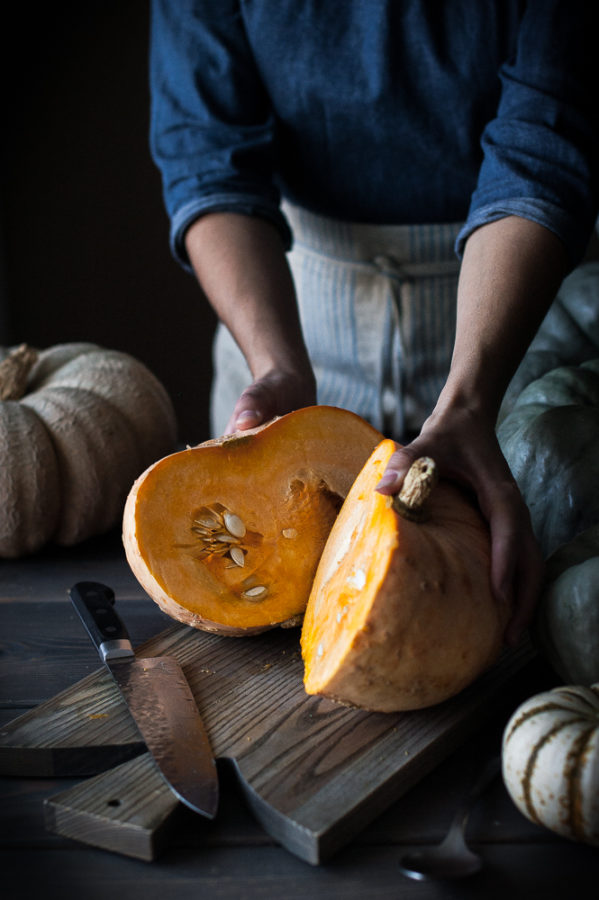
SO, lets get started!
Choose a pumpkin or winter squash and wash the outside skin before diving in. Use a sharp chefs knife to cut it in half, keeping to one side of the stem.
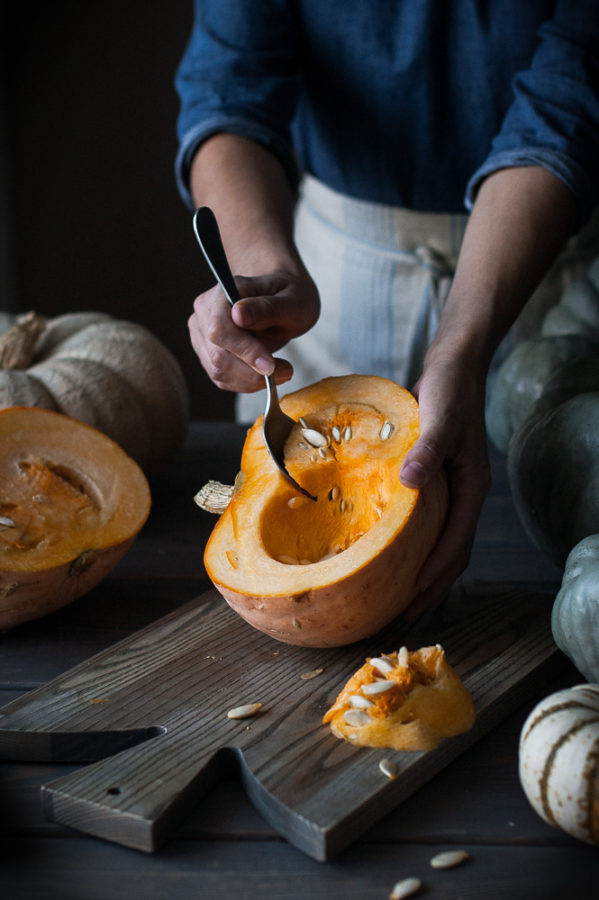
Use a large spoon to scrape out the seeds and stringy flesh from the inside of the pumpkin halves (discard seeds or save to roast later).
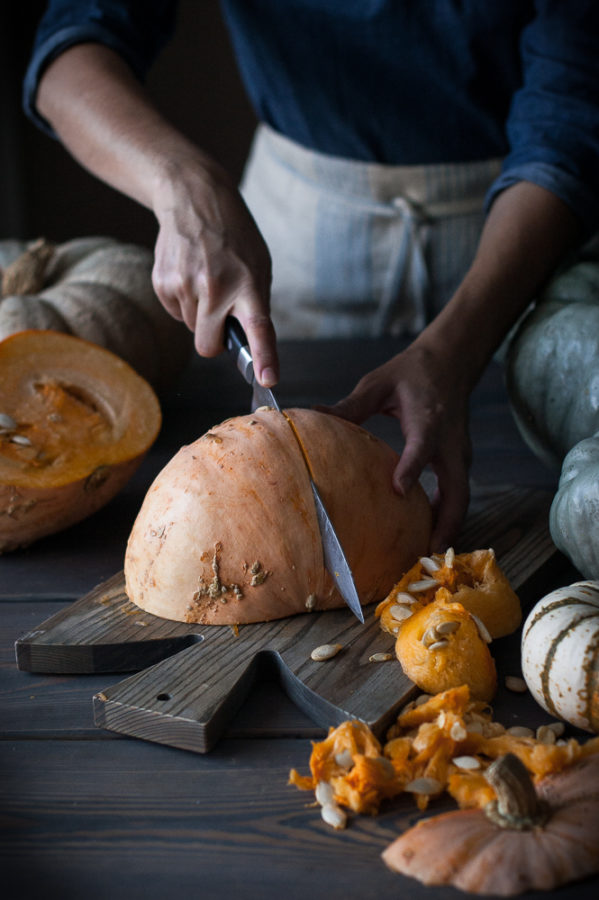
Cut the top stem and bottom knub off of the pumpkin and cut both halves in half again so that you have four quarters. If you are using a really large pumpkin you may want to cut in into six’s or oven eighths.
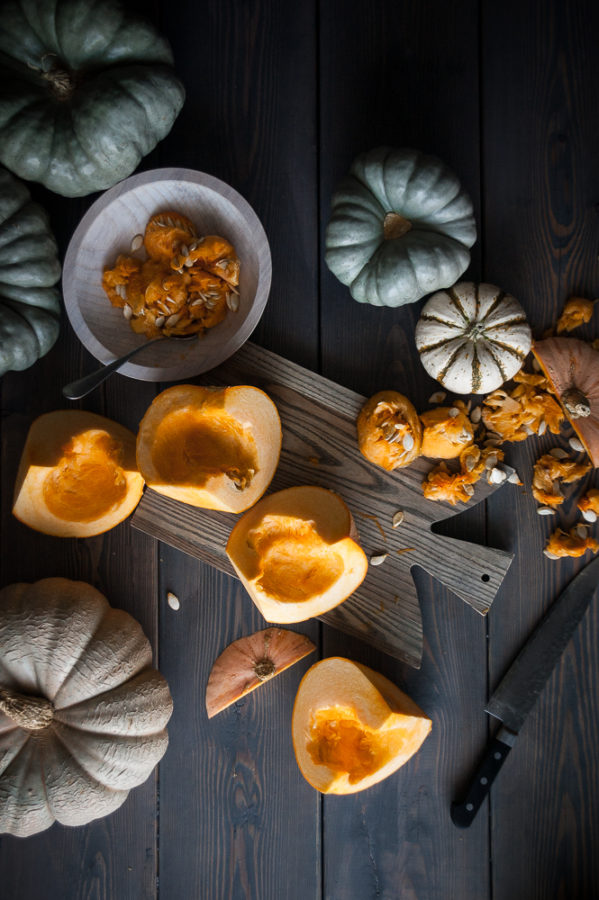

Place the pumpkin wedges cut side down on a baking sheet and pour enough water on the sheet to just cover the bottom.
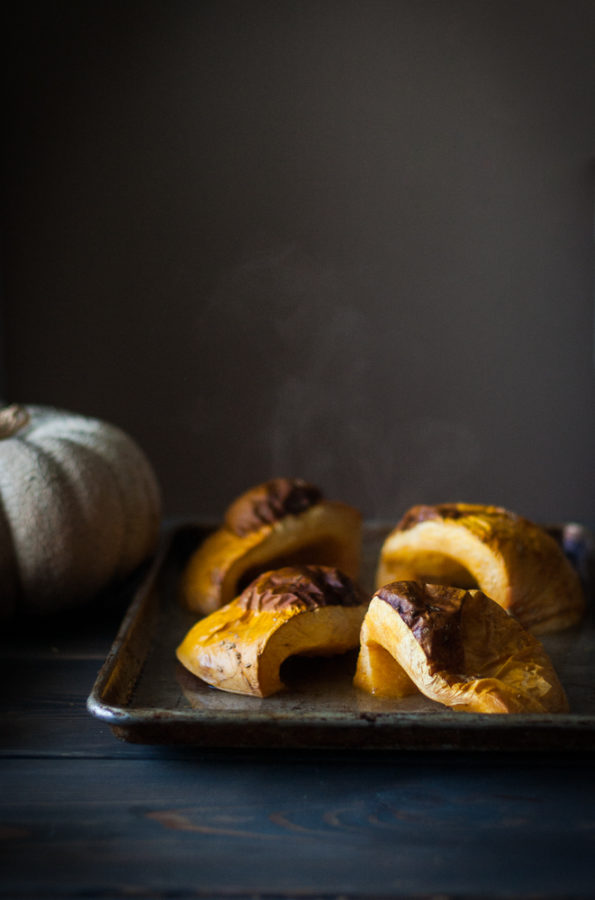
Place the sheet pan in the oven on the middle rack and roast the pumpkin at 400 degrees for 30-45 minutes. Length of time will depend on size and thickness of pumpkin quarters. Pumpkin is cooked when a fork pierces the flesh with ease – it should be very tender.
Remove the pan from the oven, drain off the water, and let the pumpkin cool until you can easily handle it.

Using your hands, peel the skin off of the pumpkins. Use a small knife to cut off any skin that doesn’t readily pull back.

Place the skinless pumpkin flesh in a blender or food processor (my Vitamix made this process almost effortless), place the lid on the blender, then puree for 30 seconds to one minute, or until smooth and silky. You may need to scrape the sides down a time or two to get all of the pumpkin pureed.

If you are not using the puree right away (and my guess is you won’t be using all of it right off the bat – depending on the size of pumpkin you roast you can end up with a LOT of puree) then I would recommend freezing what you don’t think you’ll use. I pour my pumpkin puree into Ziploc bags in 1 cup increments, label, date, and freeze so that the bags are flattened and stacked upon each other. This way the puree freezes in a thin layer with thaws quickly under warm running water whenever you might need to use it, along with the 1 cup being a good amount for most recipes. I always have pumpkin left over when I use canned, don’t you?

If you are looking for ways to use pumpkin or squash puree, here are a few of my favorite recipes (and stay tuned for a few more coming over the next few weeks!):
Maple Pumpkin + Carameled Walnut Hand Pies
Pumpkin Butter Cake + Maple Bourbon Caramel & Candied Pecans (GF)
Maple Glazed Pumpkin Buttermilk Doughnuts (GF)
Pumpkin Spice White Hot Chocolate
Fried Pumpkin Pie Cheesecake Hand Pies
Whipped Cinnamon Pumpkin Honey Butter
- 1 Pumpkin or Winter Squash
- Sharp Chefs Knife
- Baking Sheet
- Water
- Blender or food processor
- Choose a pumpkin or winter squash and wash the outside skin before diving in. Use a sharp chefs knife to cut it in half, keeping to one side of the stem.
- Use a large spoon to scrape out the seeds and stringy flesh from the inside of the pumpkin halves (discard seeds or save to roast later).
- Cut the top stem and bottom knub off of the pumpkin and cut both halves in half again so that you have four quarters. If you are using a really large pumpkin you may want to cut in into six's or oven eighths.
- Place the pumpkin wedges cut side down on a baking sheet and pour enough water on the sheet to just cover the bottom.
- Place the sheet pan in the oven on the middle rack and roast the pumpkin at 400 degrees for 30-45 minutes. Length of time will depend on size and thickness of pumpkin quarters. Pumpkin is cooked when a fork pierces the flesh with ease - it should be very tender.
- Remove the pan from the oven, drain off the water, and let the pumpkin cool until you can easily handle it.
- Using your hands, peel the skin off of the pumpkins. Use a small knife to cut off any skin that doesn't readily pull back.
- Place the skinless pumpkin flesh in a blender or food processor (my Vitamix made this process almost effortless), place the lid on the blender, then puree for 30 seconds to one minute, or until smooth and silky. You may need to scrape the sides down a time or two to get all of the pumpkin pureed.
- If you are not using the puree right away (and my guess is you won't be using all of it right off the bat - depending on the size of pumpkin you roast you can end up with a LOT of puree) then I would recommend freezing what you don't think you'll use. I pour my pumpkin puree into Ziploc bags in 1 cup increments, label, date, and freeze so that the bags are flattened and stacked upon each other. This way the puree freezes in a thin layer with thaws quickly under warm running water whenever you might need to use it, along with the 1 cup being a good amount for most recipes. I always have pumpkin left over when I use canned, don't you?
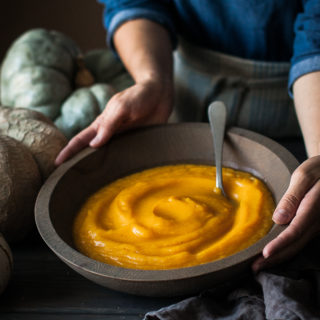



Now this is what I call a perfect timing! 🙂 Just planning on making pumpkin puree. Was wondering if you need to bake the pumpkin? Can I just boil it instead?
Hi Julia! Yay, perfect timing! ??☺️. You can boil the pumpkin but cooking it submerged in water will cause it to soak up the water and in turn,make your purée more watery(it also leaches out the nutrients into the water). I like to roast it because it’s less work, less watery, and makes for richer purée 🙂
Hi Kayley,
what a wonderful way of making pumpkin puree! And so easy! It’ll be on top of my list! And then I’ll tell you which of your above mentioned recipes I’ll have tried!
Thanks for sharing the recipe and the wonderful photos!
All the best,
Simone
This is such a great helpful post, thanks for sharing!
This is so informative and I bet it tastes so much better than the canned stuff.
I love these photos Kayley, so gorgeous!!! <3
Aw, thank you so much, Lili!
http://time.com/money/4509466/canned-pumpkin-squash/
Very few things in life compare to a good pumpkin/squash, in my opinion. Just a few weeks ago I had THE SINGLE BEST roasted kabocha squash ever….it was utterly perfect in its sweetness, richness, and firm+malleable texture inside. Yes. I’m one of those fanatics I guess, haha! This is such a beautiful set of photos, girl!